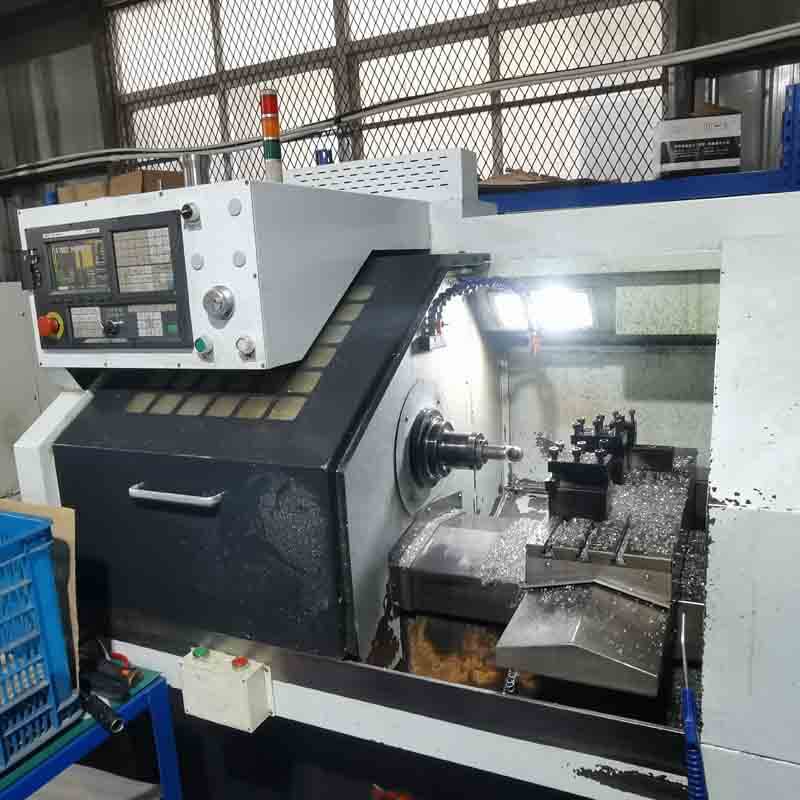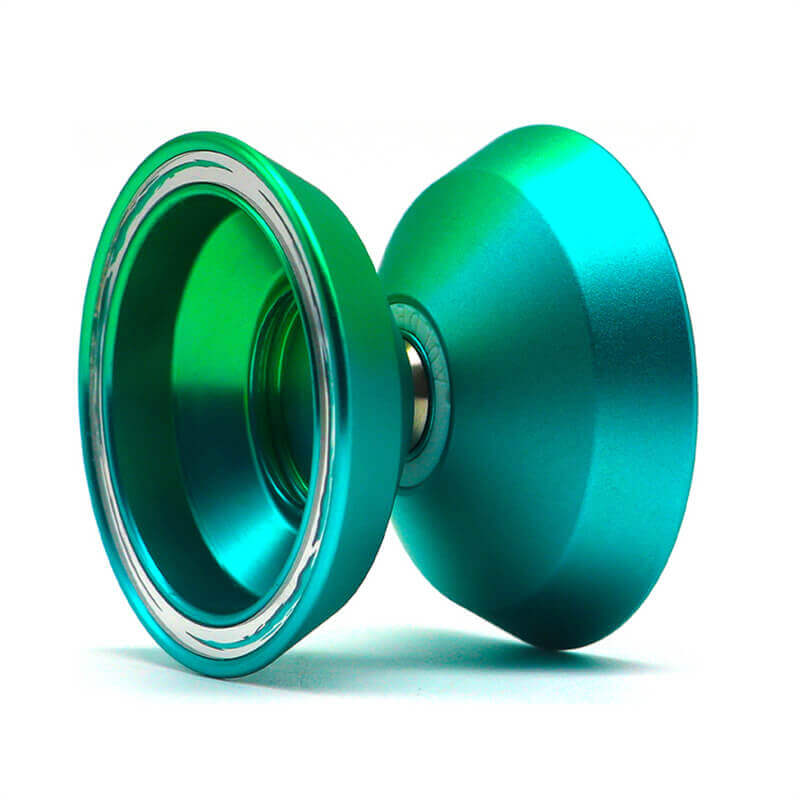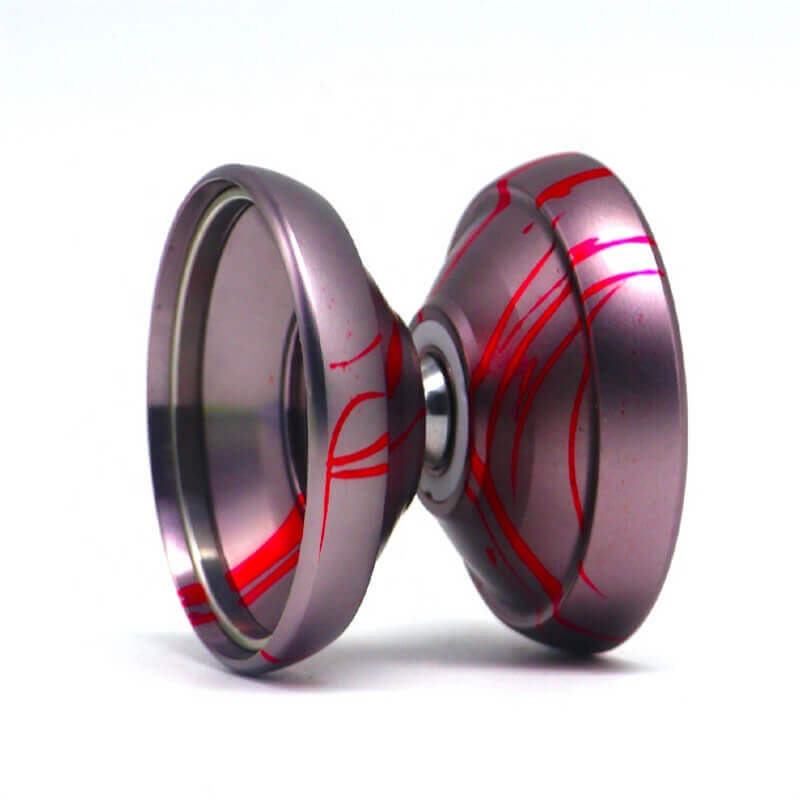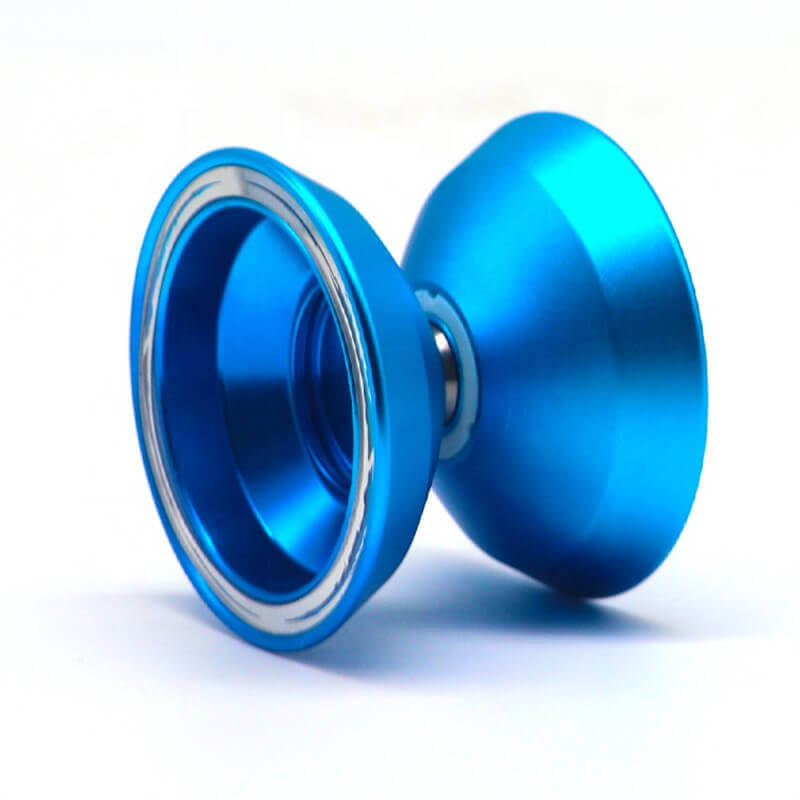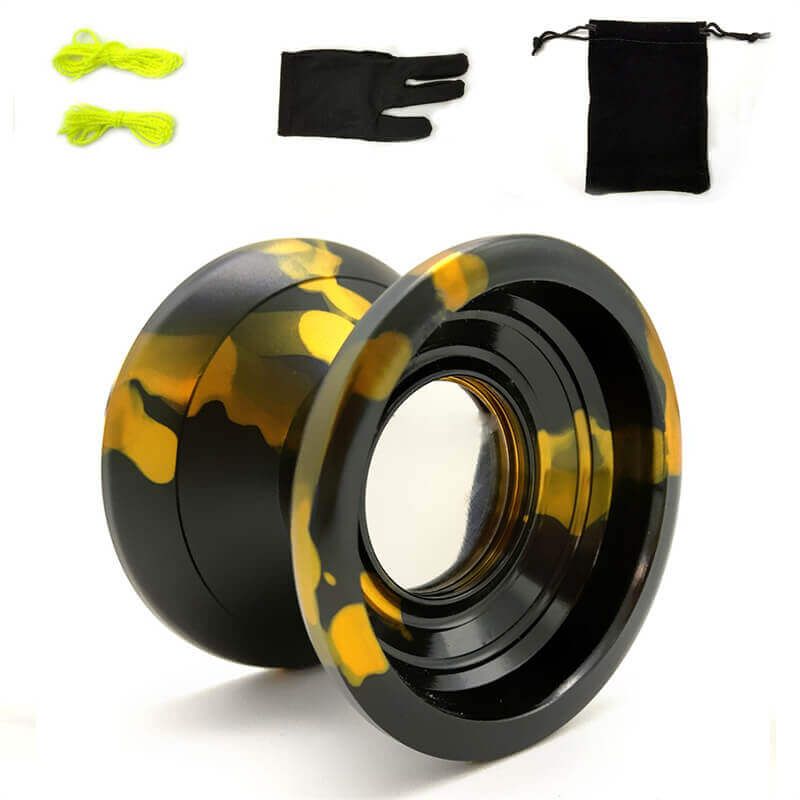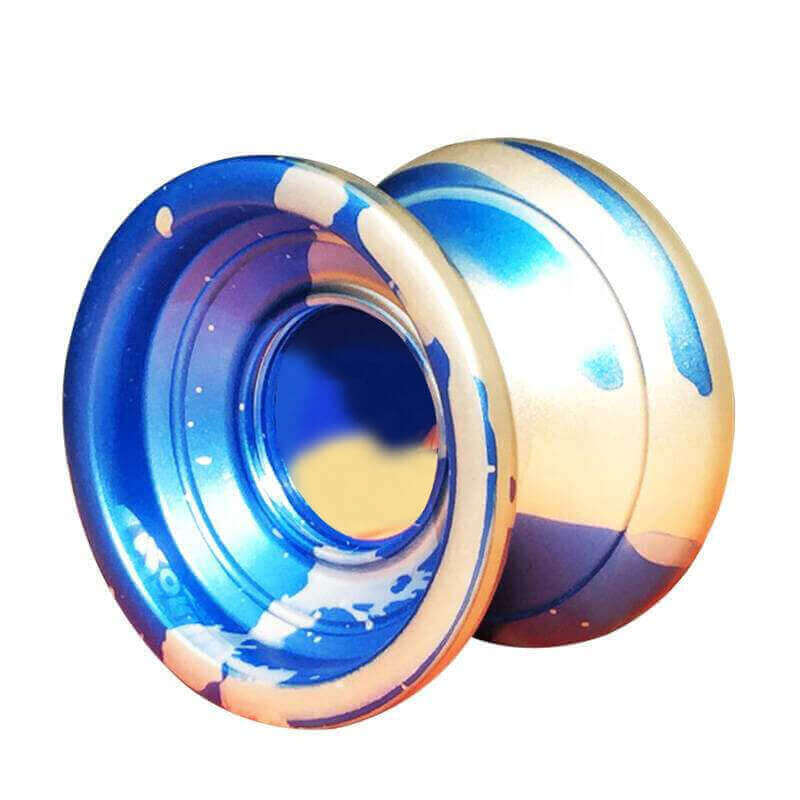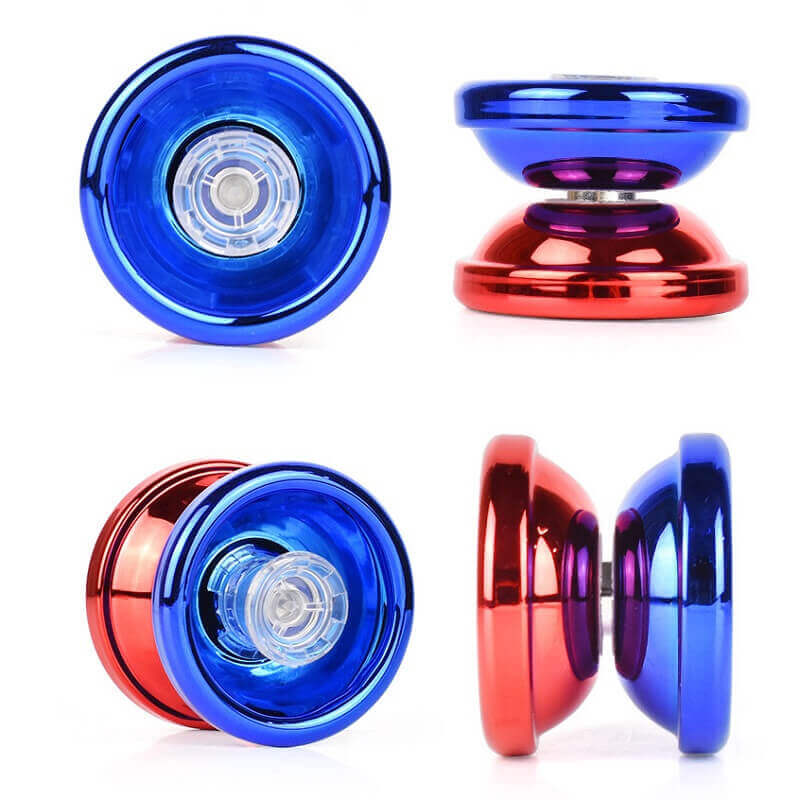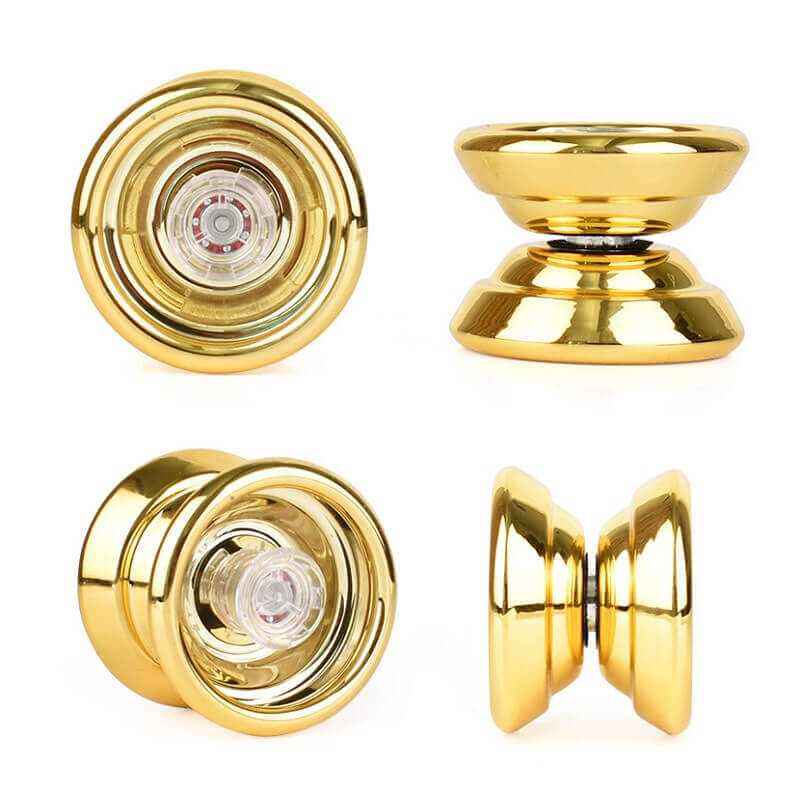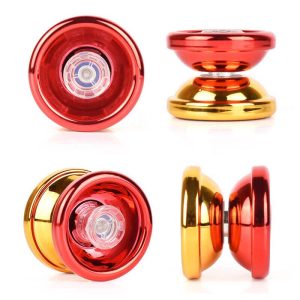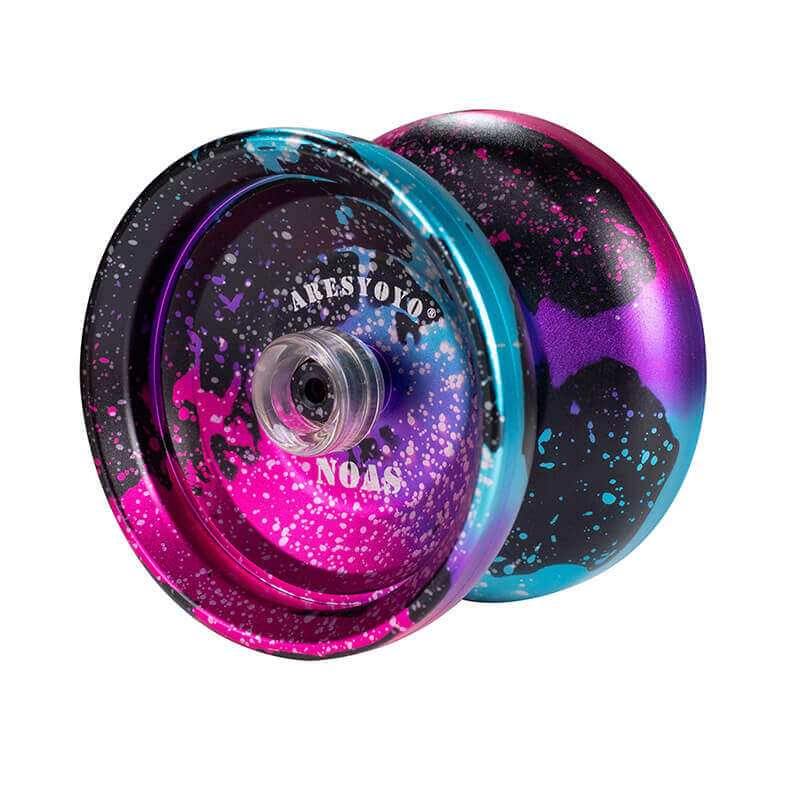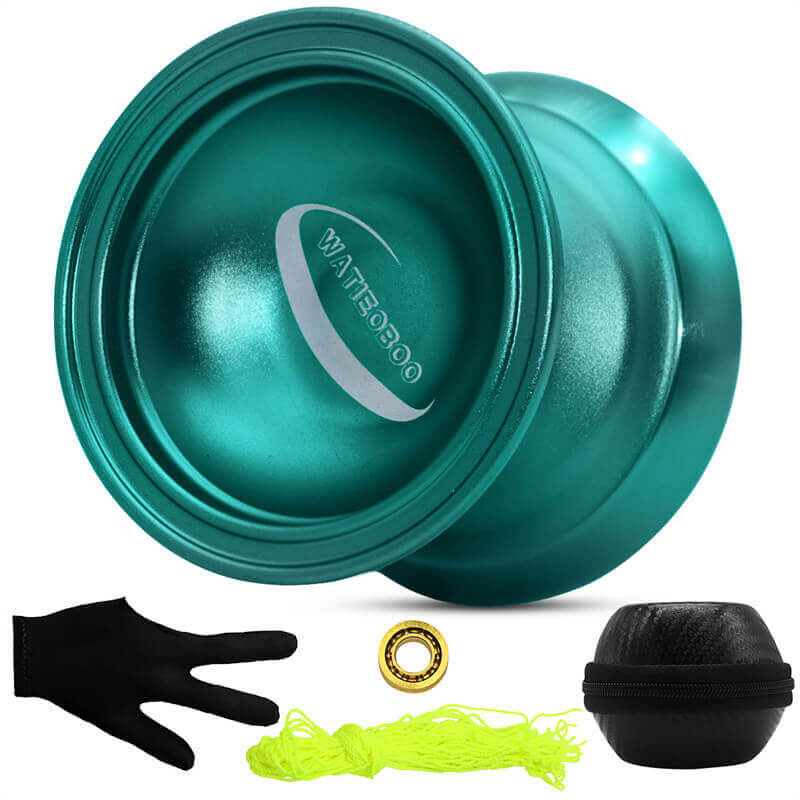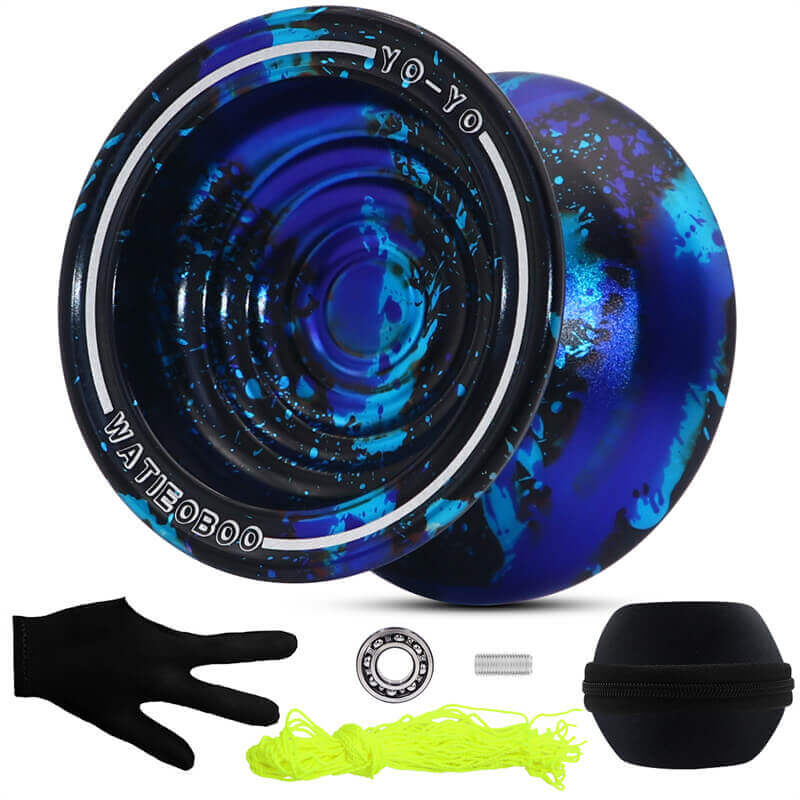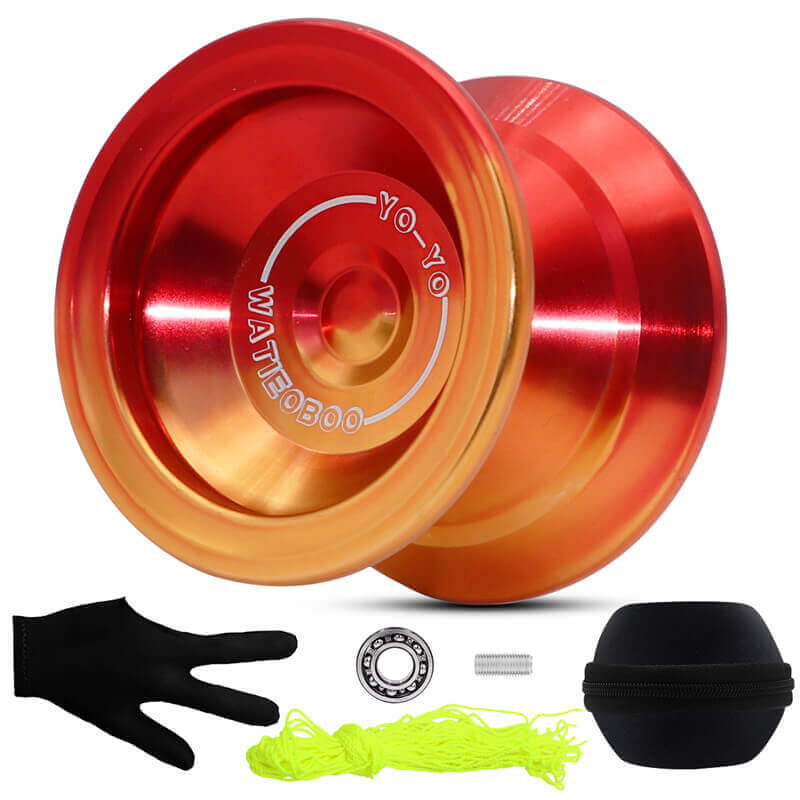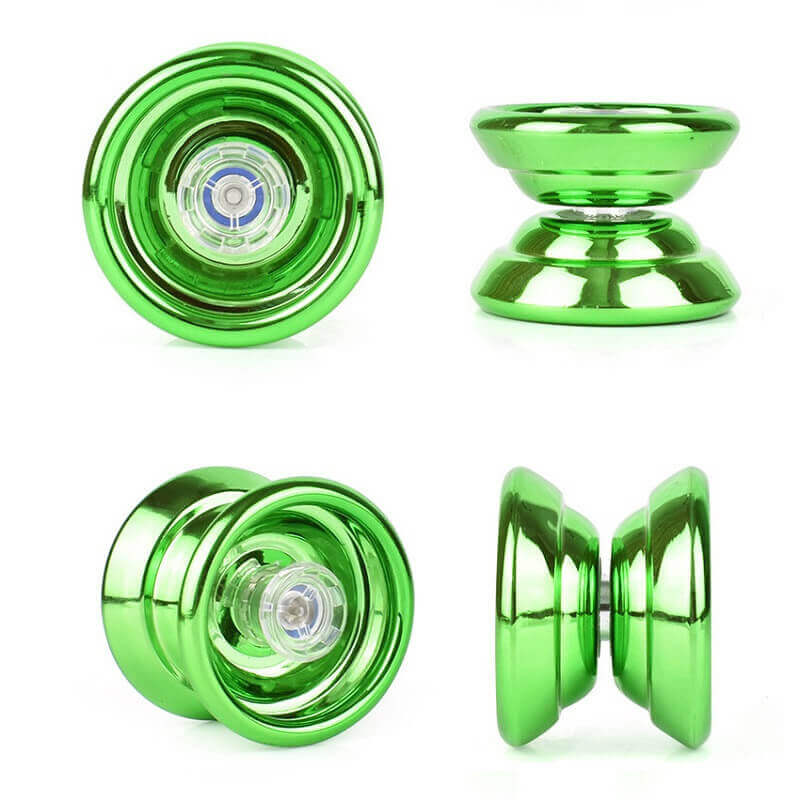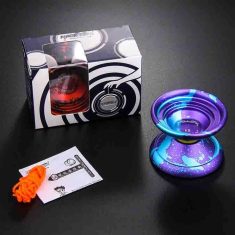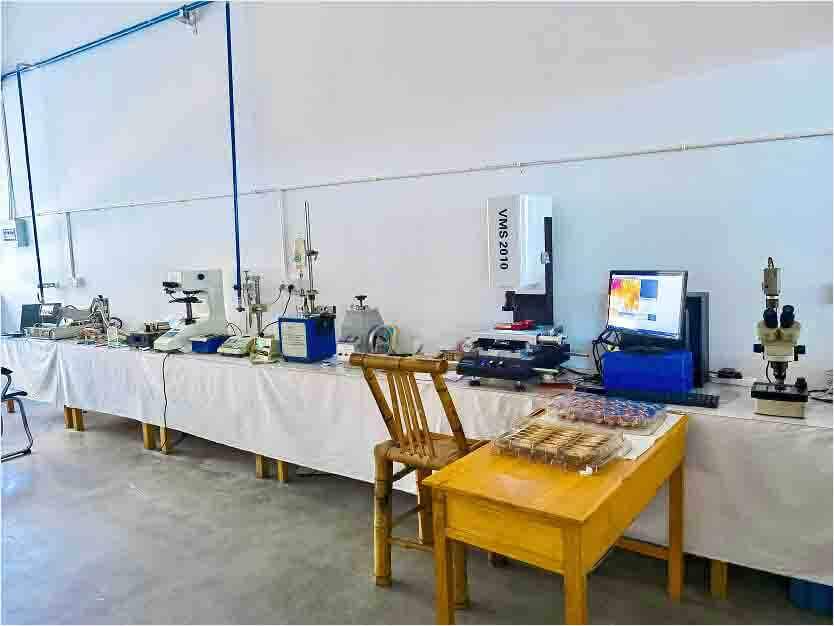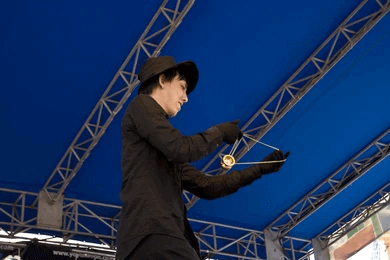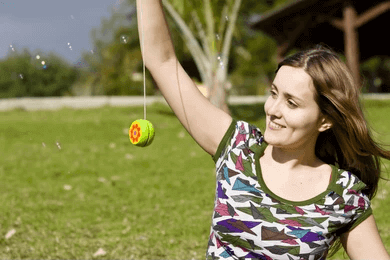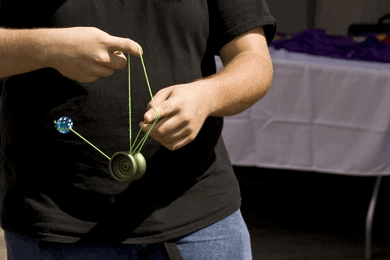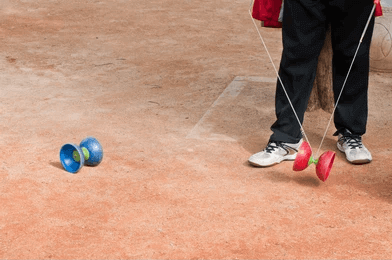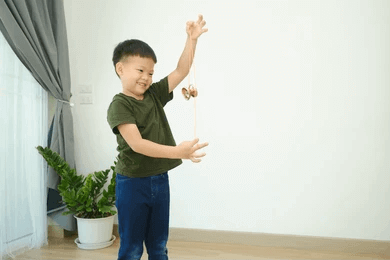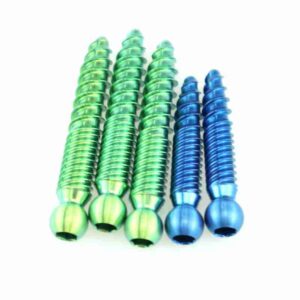A YOYO ball, commonly known as a yo-yo, is a classic and popular toy consisting of two equally sized and weighted discs connected by an axle. A string is usually attached to the axle, allowing the user to make the YOYO roll up and down by manipulating the string. The YOYO can be thrown downwards, and with proper technique, it can be made to “sleep” at the end of the string, spinning freely. Skilled users can perform a variety of tricks by manipulating the YOYO with the string, making it spin, return to the hand, and perform aerial maneuvers. YOYOs come in various designs and materials, catering to both beginners and advanced players. They have been enjoyed as a form of entertainment, skill development, and even in professional competitions.
The operation of a YOYO involves a combination of gravity, angular momentum, and string manipulation. Here’s a basic explanation of how a YOYO works:
Winding the YOYO:
To start, the user holds the YOYO in one hand and allows the string to hang freely.
The user then wraps the string around the YOYO’s axle by making a loop and pulling it over the YOYO.
Throwing the YOYO:
The YOYO is thrown downward, and as it descends, the string unwinds from the axle.
The motion imparts angular momentum to the YOYO, causing it to spin as it reaches the end of the string.
Sleeping and Tricks:
With proper technique, the YOYO can be made to “sleep” at the end of the string, spinning freely.
Skilled users can perform various tricks by manipulating the string, such as making the YOYO spin in place, performing loops, and executing more complex maneuvers.
Returning the YOYO:
Once a trick is completed or the user wishes to retrieve the YOYO, they can tug on the string.
Tugging causes the YOYO to climb back up the string and return to the user’s hand.
Responsive vs. Unresponsive YOYOs:
In the context of returning to the hand, YOYOs can be either responsive or unresponsive.
Responsive YOYOs return to the hand with a simple tug, while unresponsive YOYOs require a specific maneuver (called a bind) to return.
Yes, there are different types of YOYO balls designed to cater to various preferences, skill levels, and styles of play. Here are some common types:
Beginner YOYOs:
These YOYOs are typically responsive, meaning they return to the hand with a simple tug. They are designed for those who are new to YOYOing and are learning basic tricks.
Advanced/Unresponsive YOYOs:
These YOYOs are unresponsive, requiring a specific maneuver (called a bind) to return to the hand. They are preferred by more experienced players who engage in complex string tricks and maneuvers.
Looping YOYOs:
Specifically designed for looping tricks, these YOYOs are responsive and optimized for techniques where the YOYO repeatedly goes in and out of the string loops.
Off-string (4A) YOYOs:
Off-string YOYOs are designed to be released from the string, allowing for aerial tricks and maneuvers. The YOYO is not attached to the string during certain parts of the routine.
Counterweight (5A) YOYOs:
In counterweight YOYOing, the string is not attached to the player’s finger but to a counterweight. This style allows for more freedom of movement and unique tricks.
Metal YOYOs:
Some YOYOs are made of metal, offering increased weight and stability. These are often favored by advanced players for their performance characteristics.
Plastic YOYOs:
Plastic YOYOs are typically more affordable and suitable for beginners. They may be responsive or unresponsive, depending on the design.
Butterfly YOYOs:
Butterfly-shaped YOYOs have a wider profile, making them well-suited for string tricks. They provide a larger catch zone, making it easier to land tricks.
Wooden YOYOs:
Traditional wooden YOYOs are often favored for their classic feel. They are usually responsive and are commonly used in vintage or retro YOYO designs.
Competition YOYOs:
YOYOs designed for competitive play often feature high-performance materials, precision engineering, and specific attributes tailored to meet the demands of professional YOYO players.
Yes, designing your own YOYO and creating a brand around it is possible. Many individuals and companies have successfully introduced their unique YOYO designs to the market. If you want to design and build your own YOYO brand, here are the general steps you can consider:
Research and Idea Generation:
Research existing YOYO designs, identify gaps or opportunities in the market. Consider what features or innovations you want to incorporate into your YOYO. Generate ideas that reflect your vision for the product.
Sketch and Prototype:
Create sketches or digital renderings of your YOYO design. Once you’re satisfied with the concept, proceed to create physical prototypes. Prototype design helps test the functionality and playability. You can send us the sketches, and we can create 3D drawings or CAD drawings, making it easy to modify the dimensions and shapes.
Testing and Iteration:
If you are a seasoned player, extensively test the YOYO prototypes we produce for you. Pay attention to factors such as weight distribution, balance, spin time, and overall performance. We will make necessary adjustments based on your feedback and create updated prototypes.
Material Selection:
Carefully choose the materials for your YOYO. Common materials include plastic, aluminum, stainless steel, and titanium. Each material has its characteristics, influencing the YOYO’s performance and feel. If you want a high-end look, aluminum or titanium can be chosen. Aluminum YOYOs can be produced in various colors and shapes, while plastic is more affordable but requires mold development.
Partner with Manufacturers:
Identify manufacturers or machine shops specializing in YOYO production. Establish a partnership to bring your design to life. Work closely with the manufacturer to ensure the final product meets your specifications. You can fully trust us, and we will turn your design into reality. It’s important to check whether the YOYO supplier has a factory and equipment, as many YOYO suppliers are traders.
Branding and Packaging:
Develop a brand identity for your YOYO. This includes creating a logo, choosing a brand name, and designing packaging to complement the product. The brand should resonate with your target audience.
Legal Considerations:
Research and address any legal considerations related to YOYO production and sales. This may include trademarking your brand name, ensuring compliance with safety regulations, and understanding intellectual property rights. If you’re not familiar with this, consult with a local patent lawyer.
Market Research:
Conduct market research to understand your target audience, pricing strategies, and potential competitors. Determine the unique selling points of your YOYO to stand out in the market. Understand consumers of different age groups and design YOYOs suitable for children, perhaps with animal shapes or cartoon shapes.
Launch and Marketing:
Plan a launch strategy for your YOYO. This may include creating a website, establishing a presence on social media, and reaching out to the YOYO community. Consider collaborations with influencers or hosting promotional events. If you don’t know how to build a website, we can help you create a YOYO ball website.
Distribution:
Decide on the distribution channels for your YOYO. This could include selling directly through your website, partnering with retailers, or participating in YOYO events and competitions. Actively participate in various YOYO competitions to expand your brand’s awareness.
Feel free to ask if you need further clarification or assistance with any step.
There are countless YOYO tricks ranging from basic maneuvers to highly advanced and intricate stunts. Here are some popular YOYO tricks categorized by skill level:
Beginner Tricks:
Sleeper: Throwing the YOYO to make it spin at the end of the string without returning immediately.
Walk the Dog: Allowing the YOYO to roll on the ground, similar to walking a dog.
Rock the Baby: Creating a cradle motion with the YOYO while it swings back and forth.
Around the World: Making the YOYO travel in a circular motion around the player.
Intermediate Tricks:
The Elevator: Lifting the YOYO up and down the string in a controlled manner.
Split the Atom: A trick involving a complex series of movements with the YOYO spinning in the center of the string.
Braintwister: A trick where the YOYO is manipulated to twist around the string in a spiraling motion.
Skin the Cat: A trick where the YOYO is swung through a loop created by the player’s opposite hand.
Advanced Tricks:
Double or Nothing: Landing the YOYO on a double string formation and returning it smoothly.
Hidemasa Hook: A trick involving a wrist-mount and a slack formation.
Kwijibo: A complex series of movements that involve multiple string segments.
Black Hops: Performing consecutive hops with the YOYO while incorporating intricate string movements.
Expert/Professional Tricks:
Yuuki Slack: An advanced slack trick named after professional YOYO player Yuuki Spencer.
Mickey’s Bind: A bind maneuver popularized by YOYO legend Mickey.
Rancid Milk: A complex slack trick with multiple twists and turns.
Eli Hop: Repeatedly hopping the YOYO up and down in a controlled manner.
Superman: A high-speed trick involving complex string formations and body movement.
Yes, absolutely! YOYOing is a skill that can be learned by people of all ages. It’s a rewarding and enjoyable hobby that provides a mix of entertainment and a sense of accomplishment as you progress in learning various tricks. Here are some key points to consider:
Beginner-Friendly YOYOs: There are YOYOs specifically designed for beginners. These YOYOs are often responsive, meaning they return to your hand with a simple tug on the string, making it easier for beginners to control.
Online Tutorials: There are numerous online tutorials, videos, and resources available to help beginners learn the basics and progress to more advanced tricks. Many skilled YOYO players share their knowledge and expertise online.
Practice and Patience: Like any skill, learning to use a YOYO takes practice and patience. Start with the basic throws, sleeps, and returns. As you become more comfortable, you can gradually move on to more challenging tricks.
Community Support: YOYOing has a supportive and enthusiastic community. Many YOYO clubs, forums, and social media groups exist where you can connect with other players, seek advice, and share your progress.
Adaptability: YOYOs come in various styles and designs, suitable for different skill levels. As you advance, you can explore different types of YOYOs that align with your evolving preferences and style of play.
Fun for All Ages: YOYOing is not restricted by age. Both children and adults can enjoy the hobby, and it’s a great way for people of different generations to bond over a shared interest.
Yes, there are indeed professional YOYO competitions where highly skilled players from around the world showcase their talents and compete for prizes. These competitions bring together YOYO enthusiasts of all ages and skill levels to demonstrate their mastery of various tricks and routines. Some key points about professional YOYO competitions include:
International Events: YOYO competitions are held globally, and some of the most prestigious events attract participants from different countries. Competitions provide a platform for players to not only showcase their skills but also learn from and connect with others in the YOYO community.
Categories: Competitions typically have different categories based on the style of play. Common categories include 1A (single YOYO), 2A (double YOYO), 3A (double string), 4A (off-string), and 5A (counterweight). Each category emphasizes specific types of tricks and maneuvers.
Judging Criteria: Competitions are judged based on various criteria, including technical execution, creativity, trick difficulty, and overall performance. Judges use a scoring system to evaluate each player’s routine.
Freestyle Routines: Participants perform freestyle routines, which are choreographed sequences of tricks set to music. These routines allow players to express their creativity and individual style.
World YOYO Contest: The World YOYO Contest is one of the most prestigious events in the YOYO community. It attracts top players from around the world and serves as a platform to crown world champions in various categories.
National and Regional Competitions: In addition to international competitions, many countries and regions host their own YOYO events. These competitions provide opportunities for local talent to compete and gain recognition.
Sponsorship and Endorsements: Successful YOYO competitors may receive sponsorships from YOYO companies and endorsements from related brands. This support often includes YOYO equipment and financial assistance for travel to competitions.
A YOYO consists of several components, each playing a crucial role in its functionality. Here are the main parts of a YOYO:
Body:
The body of the YOYO consists of two circular discs, often referred to as the “halves” or “shells,” which are connected by an axle. The body is the main structure that holds the YOYO together.
Axle:
The axle is a rod or pin that runs through the center of the YOYO, connecting the two halves. It is the axis around which the YOYO spins. The material and design of the axle can affect the YOYO’s performance.
String:
The string is an essential component that is wound around the axle. It is the link between the player’s hand and the YOYO, allowing for control and manipulation. YOYO strings are typically made of materials like polyester or cotton.
Response System:
The response system determines how the YOYO returns to the hand after a throw. It creates friction between the YOYO and the string, allowing the YOYO to “catch” and return. There are different response systems, including friction stickers, pads, or recessed areas on the YOYO for response.
Bearing:
Some YOYOs, especially unresponsive models, feature a bearing that sits on the axle. The bearing reduces friction, enabling longer spin times. Bearings can be ball bearings or other types, and they play a significant role in the YOYO’s performance.
Caps/Hubstacks:
Caps are removable discs on the outer surfaces of the YOYO. They can be customized for aesthetic purposes or used for additional features. Some YOYOs have hubstacks, which are small, freely rotating discs on the sides of the YOYO that allow for unique tricks.
Weight Rings:
In some YOYOs, especially those designed for advanced players, there are weight rings. These are additional weighted components usually located near the outer edges of the YOYO to affect its weight distribution and stability.
Response Pads or Stickers:
Response pads or stickers are part of the response system. These are typically made of rubber or silicone and are placed on the inner walls of the YOYO. They provide the necessary friction for the YOYO to return to the hand.
How do I maintain my YOYO?
Proper maintenance of your YOYO is essential to ensure optimal performance and longevity. Here are some tips on how to maintain your YOYO:
Regular Inspection:
Periodically inspect your YOYO for any visible damage, such as cracks, dents, or loose parts. Addressing issues early can prevent more significant problems.
String Replacement:
YOYO strings wear out over time. Replace the string when it shows signs of fraying or if it has become too stretched. Regularly changing the string helps maintain consistent play.
Cleaning:
Clean the bearing if your YOYO has one. Remove the bearing and clean it with a specialized bearing cleaner or rubbing alcohol. Ensure the bearing is completely dry before reassembling.
Lubrication:
If your YOYO has a bearing, lubricate it occasionally to ensure smooth and responsive play. Use a small amount of YOYO-specific lubricant and follow the manufacturer’s recommendations.
Axle Tightness:
Check the tightness of the axle. If the YOYO is responsive and returns to your hand too quickly, the axle may be too tight. If it’s unresponsive, the axle may be too loose. Adjust as needed but be cautious not to overtighten.
Response Pads/Stickers:
Inspect the response pads or stickers for wear. If they are worn down or no longer provide sufficient grip, consider replacing them. This is crucial for maintaining proper responsiveness.
Avoid Hard Surfaces:
Minimize playing on hard surfaces like concrete or asphalt, as this can lead to dents, scratches, or damage to the YOYO. Choose smooth and softer surfaces for play.
Store Properly:
When not in use, store your YOYO in a safe place, away from extreme temperatures and humidity. Protect it from direct sunlight, as prolonged exposure can affect the material and color.
Customization:
Some YOYOs allow for customization, such as changing the caps or adding weight rings. Follow the manufacturer’s guidelines for any modifications and ensure they are securely in place.
Learn Tricks Carefully:
When learning new tricks, be cautious about the surroundings to avoid accidentally hitting the YOYO against hard objects. This can prevent unnecessary damage.
Yes, there are numerous YOYO clubs and communities around the world where enthusiasts gather to share their passion for YOYOing, exchange tips, and participate in events. These clubs and communities provide a supportive environment for both beginners and experienced players. Here’s how you can find and engage with YOYO clubs and communities:
Local YOYO Clubs:
Check if there are any local YOYO clubs or meetups in your area. These gatherings often take place in community centers, hobby shops, or public spaces. Attendees share tricks, offer advice, and may even organize informal competitions.
Online Forums and Communities:
There are several online forums and communities dedicated to YOYOing. Websites like the YoYoExpert Forum, Reddit’s r/Throwers, and other social media platforms have active YOYO communities. These platforms are excellent for connecting with players worldwide, seeking advice, and sharing your progress.
Social Media Groups:
Join YOYO-related groups on social media platforms like Facebook, Instagram, and Twitter. Many players and YOYO enthusiasts use these platforms to share videos, discuss tricks, and organize events.
YOYO Contests and Events:
Attend YOYO contests and events, which often serve as a hub for the YOYO community. These gatherings may include workshops, competitions, and opportunities to meet and learn from experienced players.
YOYO Brands and Retailers:
Reach out to YOYO brands and retailers, as they may have information about local clubs or events. Many companies actively support the YOYO community and may have partnerships with local groups.
National and International Organizations:
Some countries have national YOYO organizations that promote the hobby and organize events. Additionally, there are international organizations like the International YOYO Federation (IYYF) that oversee global YOYO competitions.
Workshops and Classes:
Check if there are YOYO workshops or classes offered in your area. Some clubs or retailers may organize instructional sessions for beginners or advanced players.
You can buy YOYO balls from various retailers, both online and in physical stores. Here are some places where you can purchase a YOYO:
Online Retailers:
Amazon: Amazon offers a wide variety of YOYOs from different brands and for various skill levels. You can find both beginner-friendly YOYOs and high-performance models.
YoYoExpert: This online store specializes in YOYOs and yoyo-related accessories. They carry a broad range of YOYOs, including those suitable for beginners and professional players.
Toy Stores and Hobby Shops:
Many local toy stores and hobby shops carry YOYOs. Check with stores in your area to see if they have a selection of YOYOs for sale.
Specialty YOYO Shops:
Some shops specialize specifically in YOYOs and related accessories. These shops may have a knowledgeable staff who can help you choose the right YOYO for your skill level.
Online YOYO Brands’ Websites:
Visit the official websites of YOYO brands, as many of them sell their products directly to consumers. This is a good option if you have a specific brand or model in mind.
Sporting Goods Stores:
Some sporting goods stores may carry YOYOs in their toy or recreational sections. Check with stores like Dick’s Sporting Goods or local sporting goods retailers.
Yo-Yo Clubs and Events:
If there are YOYO clubs or events in your area, they may have vendors selling YOYOs. Attending such events could give you the opportunity to try out different models before making a purchase.
Local Markets and Fairs:
Some local markets, fairs, or community events may have vendors selling toys, including YOYOs. Check out these events for potential YOYO purchases.
What is the history of the YOYO?
Choosing the right YOYO for your skill level is crucial for an enjoyable and successful YOYOing experience. Here are some considerations to help you select the best YOYO for your skill level:
Beginner YOYOs:
If you’re new to YOYOing, consider starting with a beginner-friendly YOYO. These YOYOs are typically responsive, meaning they return to your hand with a simple tug on the string. Look for models designed for easy learning and stability.
Responsive vs. Unresponsive:
Responsive YOYOs are ideal for beginners, as they are easier to control and return to the hand effortlessly. As you advance, you may want to transition to unresponsive YOYOs, which require a specific maneuver (bind) to return and are better suited for complex tricks.
Shape and Size:
YOYOs come in various shapes, including butterfly, imperial, and modified. Butterfly-shaped YOYOs are often recommended for beginners due to their wider catch zone, making it easier to land tricks. The size of the YOYO also matters, with larger YOYOs generally being more forgiving for beginners.
Weight Distribution:
Consider the weight distribution of the YOYO. Beginners often benefit from YOYOs with a more evenly distributed weight, as they are easier to control. Advanced players may prefer YOYOs with rim-weighted designs for longer spin times and stability.
Material:
YOYOs come in various materials, including plastic, metal, and hybrid combinations. Plastic YOYOs are often more affordable and suitable for beginners. Metal YOYOs are favored by advanced players for their performance characteristics.
Brand Reputation:
Research YOYO brands with good reputations for producing quality products. Established brands often have a range of YOYOs catering to different skill levels.
Adjustability:
Some YOYOs come with adjustable features, such as response systems or the ability to add or remove weight rings. These can be useful as you progress and want to tailor the YOYO to your evolving preferences.
Reviews and Recommendations:
Read reviews from other YOYO players and seek recommendations from experienced individuals. Online forums, community websites, and social media groups dedicated to YOYOing are valuable resources for gathering information.
Budget:
Determine your budget for a YOYO. There are excellent YOYOs available at various price points, so you can find one that suits your financial considerations.
Try Before You Buy:
If possible, try out different YOYOs before making a purchase. Attend YOYO clubs, workshops, or events where you can test different models and get a feel for what works best for you.
The main difference between responsive and unresponsive YOYOs lies in how they return to the hand after being thrown. This distinction is crucial for players of different skill levels and the types of tricks they want to perform. Here’s an explanation of responsive and unresponsive YOYOs:
Responsive YOYOs:
Return Mechanism: Responsive YOYOs are designed to return to the hand with a simple tug on the string. This is achieved through a responsive response system that creates friction between the YOYO and the string.
Ideal for Beginners: Responsive YOYOs are recommended for beginners as they are easier to control. They automatically return to the hand, simplifying the learning process for basic throws, sleeps, and early tricks.
Unresponsive YOYOs:
Return Mechanism: Unresponsive YOYOs do not return to the hand with a simple tug on the string. They require a specific maneuver called a “bind” to make the YOYO return. This feature allows for longer spin times and is essential for performing advanced string tricks.
Preferred by Advanced Players: Unresponsive YOYOs are favored by more advanced players who engage in complex string tricks and maneuvers. The lack of automatic return gives them greater control over the YOYO’s movement.
Binding:
Responsive YOYOs: Because responsive YOYOs return with a tug, they don’t require binding. This makes them more suitable for beginners who are still mastering the basics.
Unresponsive YOYOs: To return an unresponsive YOYO, the player must perform a bind by wrapping the string around the YOYO in a specific way. This technique adds an element of skill and control to the player’s repertoire.
Skill Progression:
Responsive YOYOs: Beginners often start with responsive YOYOs to build a foundation of skills. As they become comfortable with basic throws and tricks, they may transition to unresponsive YOYOs.
Unresponsive YOYOs: Advanced players who have mastered the basics and want to explore intricate string tricks and longer combinations often prefer unresponsive YOYOs.
String Tricks:
Responsive YOYOs: Suitable for basic tricks, loops, and early string maneuvers. The automatic return simplifies the learning process.
Unresponsive YOYOs: Ideal for complex string tricks, slack tricks, and intricate combinations that require the YOYO to spin freely without returning automatically.
Yes, it is possible to make your own YOYO string. Many YOYO enthusiasts enjoy crafting their own strings, customizing them to their preferences in terms of length, thickness, and material. Making YOYO strings at home is a creative and rewarding process. Here’s a basic guide to making your own YOYO string:
Materials Needed:
Yarn or Thread:
Choose a suitable material for your string. Common options include polyester, cotton, nylon, or a blend of these materials. Each material has its own characteristics, affecting factors such as string tension and responsiveness.
Scissors:
A pair of sharp scissors will be necessary for cutting the yarn or thread to the desired length.
Candle or Lighter:
A candle or lighter can be used to melt and seal the ends of the string to prevent unraveling.
Measuring Tool:
Use a ruler or measuring tape to ensure consistency in the length of your strings.
Steps to Make YOYO String:
Measure and Cut:
Decide on the desired length for your YOYO string. Standard YOYO string lengths are typically around 100 to 110 centimeters (40 to 44 inches), but you can customize it based on your preferences. Cut the yarn or thread to the desired length.
Twist the Strands:
If you’re using multiple strands of yarn or thread, twist them together. The number of strands and the direction of the twist can impact the characteristics of the string.
Create a Loop:
Fold the twisted strands in half to create a loop at one end. This loop will be the end that attaches to the YOYO.
Tie a Knot:
Tie a secure knot at the end of the loop. This knot will be the part that goes around the YOYO axle.
Adjust Tension:
Check the tension of the string. You can adjust the tension by twisting the loop or by pulling one of the strands to tighten or loosen the string.
Melt and Seal Ends:
Use a candle or lighter to carefully melt the ends of the string, sealing them to prevent fraying.
Test and Adjust:
Test your homemade string on your YOYO. Check for the desired responsiveness and feel. If necessary, make adjustments to the length or the number of strands for your next attempt.
